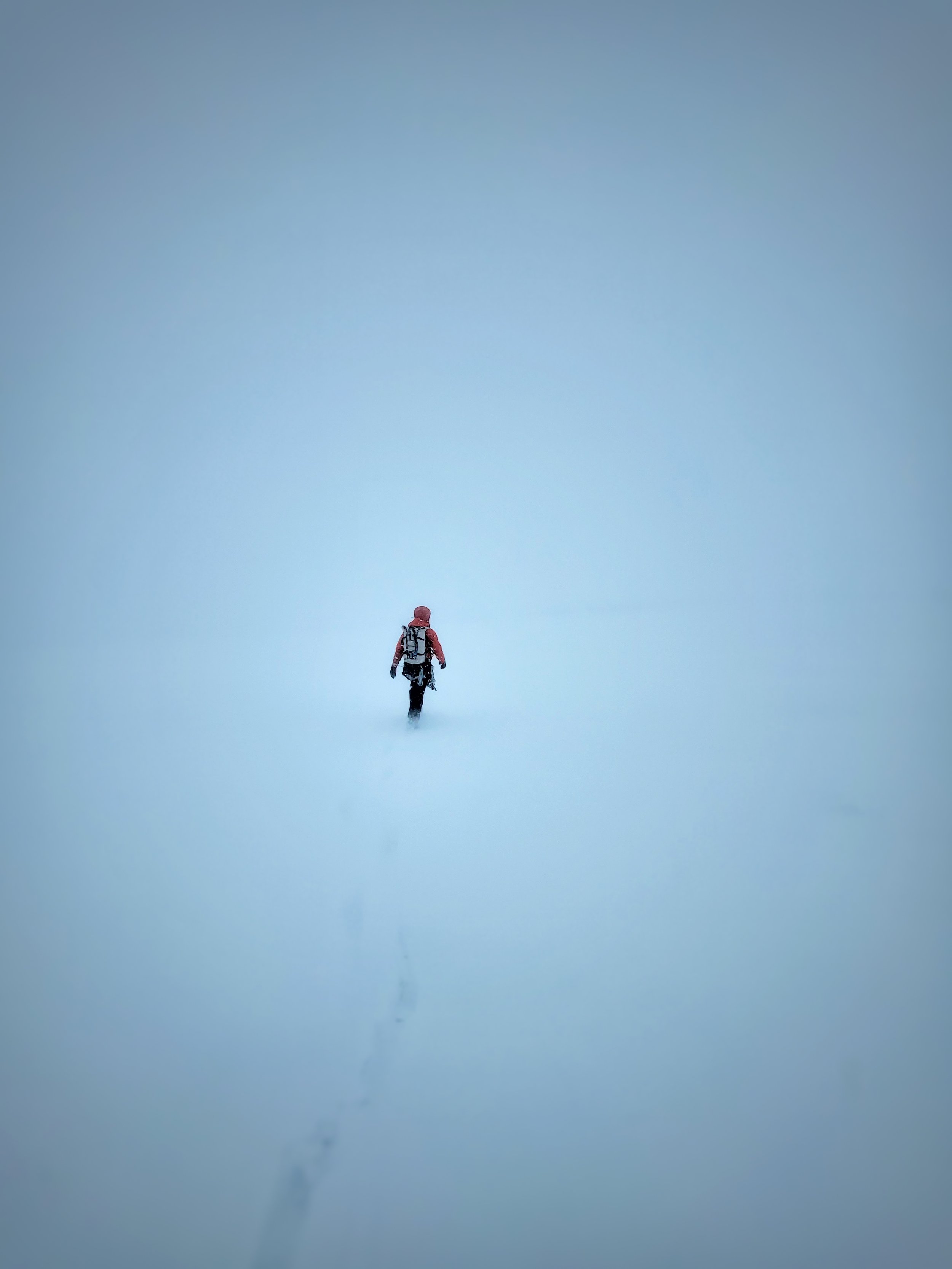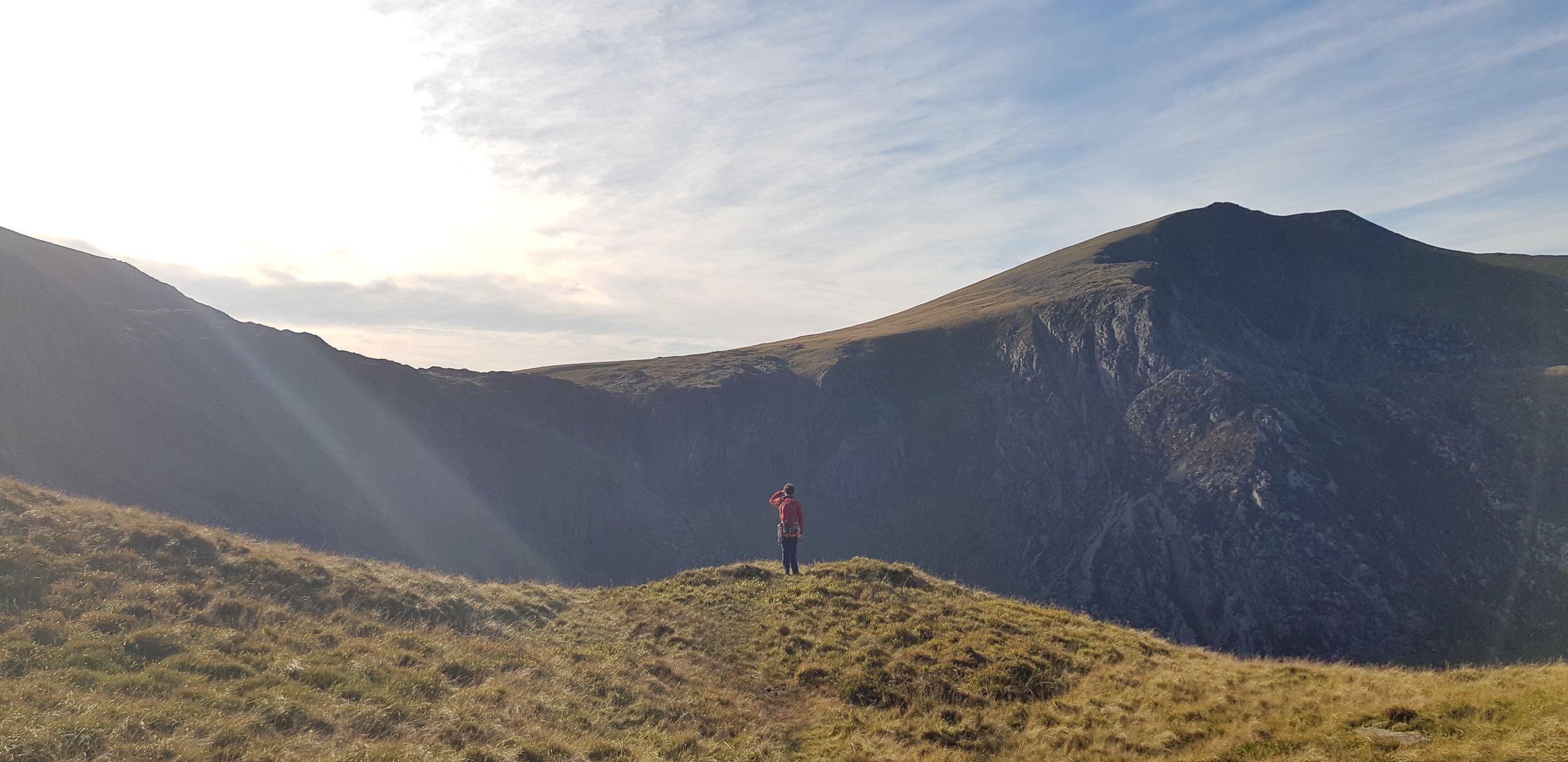Location, location, location
Dragging out a dusty pair of boots in the early summer after a winter of inactivity, sound familiar? While fair weather hiking is pleasant and extremely instagramable, there are so many adventures waiting to be experienced all year round!
The UK’s weather is famously wet and windy, a theme most British hikers are all too familiar with. While we embrace this, you can also plan your hiking calendar and tactics to stack the odds in your favour and seek out the best conditions to get out in all the seasons, whatever the weather.
Where to go?
Spring
A spring sunset on the trodden track leading to the top of the UK, Ben Nevis (Spring, 2023)
Scotland - from early May the notorious Scottish winter is likely to be in the rear-view mirror with extending daylight hours and more stable weather offering beautiful conditions on snow capped mountains. The Caledonian spring can switch between wintery spells to mid-summer heat-waves, transforming the underlying snow into bullet hard névé (compacted snow) or even raging torrents of melt-water. It is a great time of year to develop your decision making in the mountains and learn to adapt to the fluctuating conditions spring has to offer. As spring progresses the last of the winter snow will clear, unveiling a playground of classic scrambles and rock-climbs before the infamous midges infiltrate Scotland’s West Coast at the end of spring. As such, only experienced hikers with a sound understanding of navigation, cramponing and dealing with everything a spring blizzard presents should venture into the munroes unguided. Heading up high onto the Cairngorm Plateau is a great option to seek out the last of the remaining snow - how about a single day hike over Ben Macdui or a multi-day expedition to the Devil’s Point via Braeriach and the Chalamain gap?
Wandering through a whiteout on the summit of Aonach Mor, Scotland (March, 2023).
Summer
Looking town into the luscious green valley of Borrowdale, Lake District (Summer, 2022)
The Lake District - As the midges take over Scotland, it’s a great idea to shift your focus to the beautiful fells and lakes which the Lake District has to offer. The Lakes can be a tourist hot-spot and yield some remarkable traffic jams, why not escape the crowds and go on a wild-camping adventure. Seek out a circular journey, leap-frogging from tarn-to-tarn for beautiful wild camping and swimming (if you’re brave) whilst crossing a selection of Wainwrights for an expansive view of the surrounding area. The midges do drift south in Summer, so for a pleasant camp, pitch-up in a breeze and away from dense vegetation to keep the little buggers at bay. For the climbers out there, summer is also the most reliable time to tackle some prize multi-pitch climbs on the notoriously wet mountain crags, such as Scafell, Bowfell and Gable crag. Heading from the popular Old Dungeon Ghyll into Borrowdale via Pavey Ark on a hot summer’s gives a great journey. There’s even a few options to cool off by taking a dip in Stickle Tarn or the Black Moss Pot - keep an eye out for the otters too!
Stickle tarn from the base of Pavey Ark, Lake District (Summer, 2022)
Autumn
A climber looking into the impressive Cwm Idwal from Y Gribin, Snowdonia (Autumn, 2022)
Wales - With the hoards flocking to summit Snowdon finally subsiding as the summer comes to a close, North Wales has such a variety of adventures on its doorstep. Snowdonia is perfect for all mountain lovers, with just a 1 hour drive between stunning hiking over Snowdonia’s 3000ft mountains, the best scrambling in the UK (my opinion) and world-class climbing on sea-cliffs, slate quarries and mountain crags. The Welsh 3000s should perk up the ears of any eager hiker, this challenge crosses 15 mountains standing over 3000ft and can be tackled in one push (under 24 hours) or broken into 3 logical segments (the Snowdon massif, Glyderau and Carneddau)…perfect for a long weekend! Read more about the Welsh 3000s here.
The evening sun dropping behind Snowdon’s south ridge. Llyn Gwynant, Snowdonia (Autumn, 2022)
Winter
Negotiating steep slopes beneath the east face of Aonach Mor, Scotland (Winter, 2022)
Scotland - With Scotland sitting at a higher latitude than the rest of the UK it reliably holds winter conditions from January through March. Scottish winter transforms the highlands from its summer appearance, providing a whole variety of new adventures… even to a seasoned visitor. Whilst its surroundings are beautiful and comparable to that of Norway and the Alps, the Scottish winter has a split-personality and can be an extremely hostile place, with extreme weather and conditions making it a challenge for even the most accomplished hikers. Experience gained from summer hiking can be developed and new skills learned (avalanche awareness, cramponing etc) to make the playground of the Scottish mountains more accessible than you’d imagine. Personally I would recommend formal training and a conservative approach to kick-start your Scottish mountaineering journey, allowing you to gain confidence and experience as you progress onto bigger and more exciting exploits. The scope of the Scottish winter is huge and what’s even better is how much it varies from year to year… never running out of new adventures!
An evening ascent of the Mystical Bidean Nam Bian in Glencoe, Scotland (Winter, 2022)








